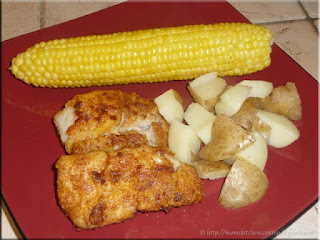I picked up another five dozen ears of corn from the only local farmer close to use selling yellow corn. Despite the adverse weather conditions and price of peaches and cream corn in town ($6/doz), his price is quite good at $3 per dozen. He's only about a mile out of town so that is a nice bonus. Yellow corn is a sweet corn with a lower sugar content than bi-colour corn so it is better for freezing and canning.
Whole kernel corn is sometimes called niblet corn. It is very easy to freeze for later use. The corn is blanched on the cob then quickly cooled and cut from the cob. The cobs are reserved from other corn products (eg. corn syrup, corn stock, corn jelly) while the whole kernels are packaged into freezer bags, labeled and froze. I ended up with 4 gallon freezer bags and a quart freezer bag of whole kernel corn. This will not be enough to get us through to the following growing season but it was a good start.
We had pan fried cod, steamed potatoes and corn on the cob for dinner that night. Just look at that gorgeous, mouthwatering cob of corn! Corn on the cob can be prepared in the husk on the grill, steamed or boiled. By far, we prefer grilling or steaming the corn for a tender, juicer cob that is higher in nutrients than corn that has been boiled. The nice thing about grilling corn on the cob is there's minimal clean-up. A little butter and sea salt topping the corn on the cob had our lips smacking! We only enjoy corn on the cob in season as it takes up too much room in the freezers when left on the cob. After enjoying our simple yet delicious easy summer dinner it was time to make corn stock.
Corn cobs are traditionally a waste product from home food preservation or a meal. However, if the corn has been cut from the cob for canning, drying or freezing, the cobs can be used to make corn syrup, corn stock and corn jelly. In essence a lovely edible product is made from what otherwise would go to waste. Think about it, 5 dozen ears of corn is 60 cobs which is more than enough to make those three products free from something you would normally throw out before throwing out the spent cobs.
Corn stock is one of those must have vegetable stocks to have on hand. It adds a rich flavour to soups, stews and vegetables. I made corn stock from one dozen ears of the spent corn cobs. This was very easy to do. I simply covered them with water in a large stock pot, brought to a boil then simmered for a little over an hour. Then I strained the stock, ladled into hot jars and processed in a pressure canner for 35 minutes at 10 lb of pressure. I didn't have enough of the corn stock to fill the final jar so used a Bernardin storage cap and popped it into the freezer.









2 food lovers commented:
I just hickory smoked two dozen ears of corn yesterday along with some ribs. Both came out great. We ate about four ears of corn at dinner and then I cut and froze the rest. Smoked corn pairs well with vegetable black bean soup in the winter and black bean and corn salad in the summer.
I never heard of any of those corn products.
Thanks for sharing the corn stock with us, GG.
Have a great week!
Post a Comment